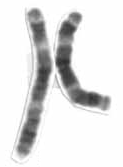Chromosome 3q29 Deletion Syndrome

A number sign (#) is used with this entry because it represents a contiguous gene deletion syndrome on chromosome 3q29.
Clinical FeaturesWillatt et al. (2005) reported the identification of 6 patients with 3q29 microdeletion syndrome. The clinical phenotype was variable despite an almost identical deletion size. The phenotype included mild to moderate mental retardation, with only slightly dysmorphic facial features that were similar in most patients: long and narrow face, short philtrum, and high nasal bridge. Autism, gait ataxia, chest wall deformity, and long and tapering fingers were noted in at least 2 of the 6 patients. Additional features, including microcephaly, cleft lip and palate, horseshoe kidney and hypospadias, ligamentous laxity, recurrent middle ear infections, and abnormal pigmentation, were observed, each in a single patient.
Digilio et al. (2009) reported 2 mother-daughter pairs in which the mother and daughter shared a 1.5-Mb deletion at chromosome 3q29. All 4 individuals had delayed psychomotor development with mild to moderate mental retardation and/or learning disabilities with speech delay. All had low birth weight, microcephaly, high nasal bridge, and short philtrum, and 3 had clinodactyly of the toes. Otherwise, dysmorphic features were variable and yielded no discernible phenotype. Digilio et al. (2009) noted the familial transmission of the chromosomal defect and suggested that it may be more common than previously thought.
Li et al. (2009) reported a 6-month-old boy with multiple congenital anomalies who inherited a paternal 1.3- to 1.4-Mb deletion at chromosome 3q29. The boy had primary pulmonary hypertension, patent ductus arteriosus (PDA), subvalvular aortic stenosis, and gastroesophageal reflux, and required neonatal intensive care for 57 days after birth due to complications of meconium aspiration. He had mild dysmorphic features, including posteriorly rotated ears, shallow orbits, frontal bossing, prominent nose, long thin lip, and broad face. He also had bilateral sandal gap toes, single palmar creases, and bilateral inguinal hernia. However, he was developmentally normal at age 6 months. His father had a history of PDA and pulmonic stenosis at birth and mild developmental delay in childhood, with normal cognition as an adult.
Quintero-Rivera et al. (2010) reported 2 unrelated patients, a 10-year-old Caucasian girl and a 15-year-old Hispanic boy, with chromosome 3q29 deletion syndrome. Common clinical features included delayed psychomotor development with delayed waking and poor motor skills, autism with speech delay, mental retardation, and psychiatric disturbances, including aggression, anxiety, hyperactivity, and bipolar disorder with psychosis in 1. Both had dysmorphic features, including high nasal bridge, asymmetric face, and crowded/dysplastic teeth; 1 had micrognathia and epicanthal folds. Both had tapered fingers. The girl had a family history significant for a father and paternal grandfather with bipolar disorder, and a maternal cousin and aunt with attention-deficit hyperactivity disorder and anorexia nervosa, respectively. Chromosomal microarray analysis identified de novo 1.6-Mb and 2.1-Mb deletions at chromosome 3q29 in the girl and boy, respectively. Quintero-Rivera et al. (2010) noted that the dysmorphic features of this disorder are highly variable, but that the psychiatric manifestations often include cognitive defects, autism, and other psychiatric disorders.
Molecular GeneticsThe microdeletion in the patients studied by Willatt et al. (2005) was approximately 1.5 Mb, with molecular boundaries mapping within the same or adjacent BAC clones at either end of the deletion in all patients. The deletion encompassed 22 genes, including PAK2 (605022) and DLG1 (601014), which are autosomal homologs of 2 known X-linked mental retardation genes, PAK3 (300142) and DLG3 (300189). The presence of 2 nearly identical low-copy repeat (LCR) sequences in BAC clones on each side of the deletion breakpoint suggested that nonallelic homologous recombination is the likely mechanism of disease causation in this syndrome.
Mulle et al. (2010) identified a region on chromosome 3q29 in which copy number variation (CNV) was significantly associated with schizophrenia (SCZD; 181500). The initial study involved 245 unrelated patients with SCZD and 490 controls, all of Ashkenazi Jewish descent. Combined with prior CNV studies and additional SCZD cohorts, the authors identified chromosome 3q29 deletions in 6 of 7,545 patients compared to 1 of 39,748 controls (odds ratio of 16.98; corrected p value = 0.02). The minimum deletion region overlapped with that observed in the group of children with moderate mental retardation and autism.
Quintero-Rivera et al. (2010) proposed a role for haploinsufficiency of the FBXO45 (609112), DLG1 (601014), and PAK2 (605022) genes in the psychiatric manifestations of 3q29 deletion syndrome, since these genes play putative role in synaptic transmission.
Kaminsky et al. (2011) performed a large CNV case-control study comprising 15,749 International Standards for Cytogenomic Arrays cases and 10,118 published controls, focusing on recurrent deletions and duplications involving 14 copy number variant regions. Compared with controls, 14 deletions and 7 duplications were significantly overrepresented in cases, providing a clinical diagnosis as pathogenic. The 3q29 deletion was identified in 9 cases and no controls for a p value of 0.0147 and a frequency of 1 in 1,750 cases.